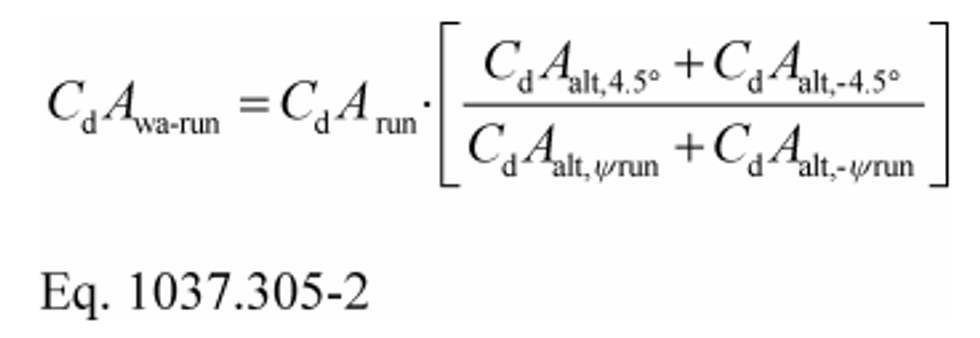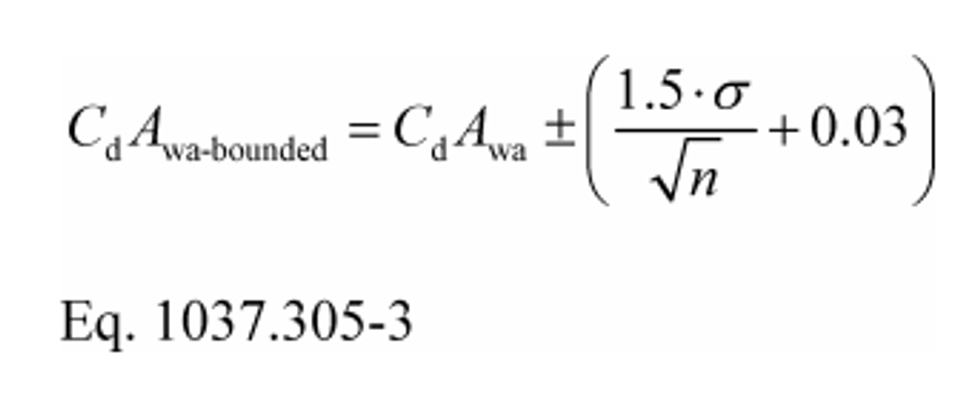['Air Programs']
['Air Emissions']
07/08/2024
...
To perform a selective enforcement audit with respect to drag area for tractors, use the reference method specified in §1037.525; we may instead require you to use the same method you used for certification. The following provisions apply instead of 40 CFR 1068.415 through 1068.425 for a selective enforcement audit with respect to drag area:
(a) Determine whether a tractor meets standards as follows:
(1) We will select a vehicle configuration for testing. Perform a coastdown measurement according to §1037.528 with the vehicle in its production configuration. If the production configuration cannot be connected to a standard trailer, you may ask us to approve trailer specifications different than §1037.501(g)(1) based on good engineering judgment. Instead of the process described in §1037.528(h)(12), determine your test result as described in this paragraph (a). You must have an equal number of runs in each direction.
(2) Measure a yaw curve for your test vehicle using your alternate method according to §1037.525(b)(3). You do not need to test at the coastdown effective yaw angle. You may use a previously established yaw curve from your certification testing if it is available.
(3) Using the yaw curve, perform a regression using values of drag area, CdAalt, and yaw angle, ψalt, to determine the air-direction correction coefficients, a0, a1, a2, a3, and a4, for the following equation:

(4) Adjust the drag area value from each coastdown run, CdArun, from the yaw angle of each run, ψrun, to ±4.5° to represent a wind-averaged drag area value, CdAwa by applying Eq. 1037.305-1 as follows:

(5) Perform additional coastdown measurements until you reach a pass or fail decision under this paragraph (a). The minimum number of runs to pass is 24. The minimum number of runs to fail is 100.
(6) Calculate statistical values to characterize cumulative test results at least once per day based on an equal number of coastdown runs in each direction. Determine the wind-averaged drag area value for the test CdAwa by averaging all CdAwa-run values for all days of testing. Determine the upper and lower bounds of the drag area value, CdAwa-bounded, expressed to two decimal places, using a confidence interval as follows:

Where:
CdAwa-bounded = the upper bound, CdAwa-upper, and lower bound, CdAwa-lower, of the drag area value, where CdAwa-upper is the larger number.
CdAwa = the average of all CdAwa-run values.
σ = the standard deviation of all CdAwa-run values (see 40 CFR 1065.602(c)).
n = the total number of coastdown runs.
(7) Determine compliance based on the values of CdAwa-upper and CdAwa-lower relative to the adjusted bin boundary. For purposes of this section, the upper limit of a bin is expressed as the specified value plus 0.05 to account for rounding. For example, for a bin including values of 5.5-5.9 m2, being above the upper limit means exceeding 5.95 m2. The vehicle passes or fails relative to the adjusted bin boundary based on one of the following criteria:
(i) The vehicle passes if CdAwa-upper is less than or equal to the upper limit of the bin to which you certified the vehicle.
(ii) The vehicle fails if CdAwa-lower is greater than the upper limit of the bin to which you certified the vehicle.
(iii) The vehicle passes if you perform 100 coastdown runs and CdAwa-upper is greater than and CdAwa-lower is lower than the upper limit of the bin to which you certified the vehicle.
(iv) The vehicle fails if you choose to stop testing before reaching a final determination under this paragraph (a)(7).
(v) You may continue testing beyond the stopping point specified in this paragraph (a)(7). We may consider the additional data in making pass/fail determinations.
[86 FR 34463, Jun. 29, 2021]
['Air Programs']
['Air Emissions']
UPGRADE TO CONTINUE READING
Load More
J. J. Keller is the trusted source for DOT / Transportation, OSHA / Workplace Safety, Human Resources, Construction Safety and Hazmat / Hazardous Materials regulation compliance products and services. J. J. Keller helps you increase safety awareness, reduce risk, follow best practices, improve safety training, and stay current with changing regulations.
Copyright 2025 J. J. Keller & Associate, Inc. For re-use options please contact copyright@jjkeller.com or call 800-558-5011.
